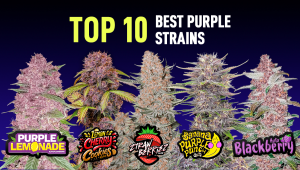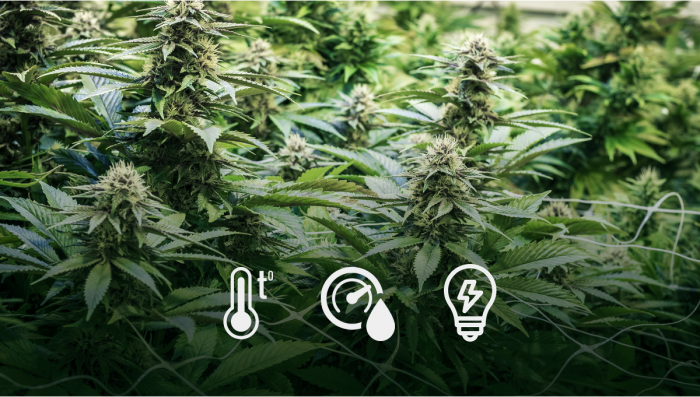The Best Temperature To Grow Cannabis
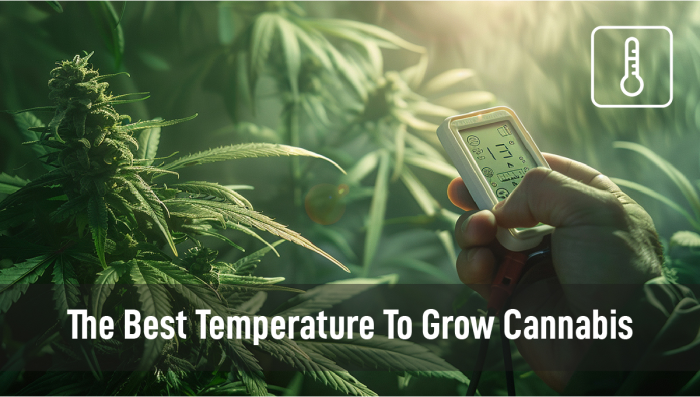
- 1. Theoretical considerations
- 1. a. The temperatures in the root zone
- 2. Temperature requirements at different stages
- 2. a. Seedling stage
- 2. b. Vegetative stage
- 2. c. Early- to mid-flowering stage
- 2. d. The last weeks of flowering
- 2. e. Drying and curing
- 3. What are the risks of wrong temperatures?
- 3. a. When it’s too cold
- 3. b. When it’s too hot
- 4. How to control temperature in a cannabis grow room?
- 4. a. How can you control temperature outdoors?
- 5. Final thoughts
There’s an old adage that cannabis loves the same temperatures as humans. We feel the most comfortable at around 25°C (77°F), and when the readings on our thermometers deviate too much from these numbers, we feel increasingly uncomfortable. And yeah, the “we” in this sentence refers both to us, humans, and our favorite plant. That pretty much covers it all and is enough for amateurs to grow very good cannabis indeed. However, if you’re striving for perfection or fighting for each extra gram, there are many finer points to consider. Read on to know all about the best temperatures for weed growing.
Theoretical Considerations
In agriculture, there’s such a term as base temperature (Tb). It’s the minimum temperature at which any development of a plant simply stops. For cannabis, Tb is rather high – around 10-12°C (50-53.5°F), making it a cold-sensitive crop. It doesn’t mean that your cannabis will severely suffer and die at colder temps. Mature plants can even live through an occasional frost, but if you want your crop to grow or better yet flourish, make sure it’s considerably warmer in your garden.
Another interesting term is Average Daily Temperature (ADT). It’s calculated as an average of hourly temperatures and obviously depends on your light cycle. For instance, if you keep your flowering plant at 12/12, with a day temperature of 25°C (77°F) and a night temperature of 15°C (59°F), it’s exactly the same in terms of ADT as keeping the temps at 20°C (68°F) both day and night.
This has some interesting implications, such as if you overheat your plants during the day, you can compensate for this with cooler temps during the night. For vegging plants or autoflowers, you can offset less-than-ideal temperature conditions with shorter or longer light cycles. For example, if it’s too hot, use the 16/8 cycle instead of the standard 18/6. Conversely, if it’s too cold, go for 20/4 or even 24/0. Unfortunately, you can’t do the same with photoperiod plants during the flowering stage – 11/13 in either direction is all the wiggle room you get.
The Temperatures in the Root Zone
When thinking about plants, people are biased to imagine only their above-ground part, while their root structure may be just as big and certainly no less important. (Earthworms and moles have a very different perspective btw.) In terms of temperature balance, the root zone plays an even bigger role than stalks, leaves, and buds.
Research has shown that the visible part of the plant can withstand severe heat and cold as long the underground part is snug and comfortable. Again, it’s the same as with people – you can walk around in winter bareheaded but not barefooted because feet (roots) are more essential for keeping the right temperature balance than the head (leaves and flowers). They use this principle in large commercial greenhouses where one can save huge amounts of money on cooling or heating costs by laying pipes with warm or chilled water through the medium and not caring much about the temperature of the air.
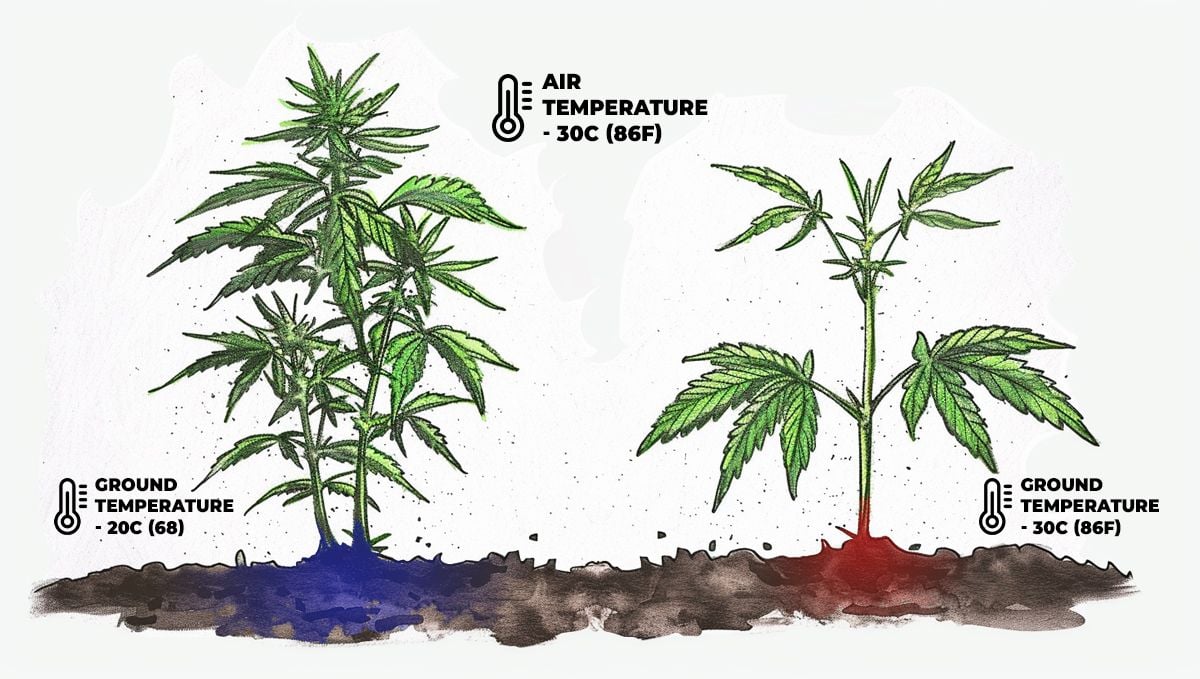
As you can imagine, this gives you some freedom, as you can think of many cheap but effective ways of regulating the temperature in the root zone – from heat mats to insulation materials to warming up or chilling your nutrient solution before watering, the list goes on. It’s definitely easier than the uphill battle of extracting all the heat generated by the grow lights in summer or, vice versa, keeping the grow room heated while also providing adequate air exchange in winter.
Temperature Requirements at Different Stages
There are some variations in the optimal temperatures between different stages of growth. Let’s look at each of them separately.
Seedling Stage
Seedlings, clones, and small plants in the first couple of weeks of their life cycle prefer the temperatures to be on the warmer side – 25-28°C (77-82°F). No less important is relative humidity (RH) – it should be high (around 70-80%), as this prevents excessive moisture evaporation at the time when the root system is still small and underdeveloped.
Actually, the thing one should care about is the balance of temperature and humidity. If you think the temps are off, well, maybe they aren’t, considering the current RH? Or if they are in fact off, maybe you should regulate humidity rather than temperature? Experienced growers use such value as VPD (Vapor Pressure Deficit) to strike the perfect balance. VPD shows you the difference between how much moisture the air currently holds and how much of it the air can hold at saturation – when dew starts to drop.
You can read more about vapor pressure deficit by following this link or use the calculator below. Just keep in mind that the calculator shows the perfect temperature/humidity balance in terms of plant development, but it doesn’t take into account such issues as mold, bud rot, or powdery mildew. These three aren’t relevant for seedlings but can plague your crop during the later stages of flowering if it’s too humid in your grow room.
The nighttime temps at this stage can be 5 degrees lower than during the day. However, some growers just keep the lights on around the clock, and that’s also ok for seedlings.
Vegetative Stage
When the plant reaches a certain size and begins active vegetative growth (usually at 2 weeks from seed), it stops being so finicky about the temperature as before but still prefers warm conditions. The ideal day temperature would be 24-26°C (75-79°F), but don’t beat yourself up if you go a couple of degrees outside this range. The temps at lights off can drop a bit lower than for seedlings – between 5-10 degrees.
Early- to Mid-Flowering Stage
As soon as budding begins, temperature requirements change again and this time more dramatically. Flowering cannabis plants thrive when the temps are cooler than before – at around 22-25°C (72-77°F). This is in keeping with how things happen in nature – the flowering stage starts at the end of summer when the weather becomes cooler. Lowering the temperature in your grow room sends yet another signal to the plant to hurry with the flowering before it’s too late.
Beside, lower temps help conserve the aroma of buds (by reducing the evaporation of terpenes) as well as their potency in the form of THC and other cannabinoids. The temperature drop at lights off can be the same as before – 5-10 degrees.
| Growth Stage | Day Temperature | Nighttime Temp Drop | VPD |
|---|---|---|---|
| Seedling | 25-28°C (77-82°F) | 5 degrees | 0.6-0.7 |
| Veg | 24-26°C (75-79°F) | 5-10 degrees | 0.8-1.0 |
| Early Flower | 22-25°C (72-77°F) | 5-10 degrees | 1.0-1.5 |
| Late Flower | 21-23°C (70-73°F) | 5-10 degrees | 1.1-1.5 |
| Drying/Curing | 15-21°C (60-70°F) | NA | 0.8-0.9 |
The Last Weeks of Flowering
When the plants are nearing harvest time, it’s a good idea to lower day temperatures even further – to 21-23°C (70-73°F) – and for the same reasons as before. Besides conserving terpenes and cannabinoids, a cooler environment helps prevent foxtailing and in general makes the buds more compact and dense.
Lower temperatures, especially at night, also help bring out anthocyanins – natural pigments responsible for purple and other interesting colors. If you want this, make sure your nighttime temps drop by up to 10 degrees but not below the base temperature of 10-12°C (50-53.5°F). Also, watch out for mold, bud rot, and powdery mildew – when temperatures decrease too sharply and the dew drops, the risks of these fungal infections are much higher.

Drying and Curing
Generally, the more slowly you dry and cure your buds, the better their quality, and for slower drying, you need lower temperatures. However, don’t overdo it, as the cooler it is in your dry room, the higher the risk of mold. The ideal range is between 15-21°C (60-70°F). The ideal VPD is around 0.8 (see the calculator above).
What Are the Risks of Wrong Temperatures?
Keeping the temperature in your garden within the ideal or even acceptable limits isn’t always easy, so one should be aware of risks of going beyond the perfect range and know what are the signs of trouble.
When It’s Too Cold
We’ve already mentioned that at temperatures lower than 10-12°C (50-53.5°F) the development of cannabis stops. Very cool environment can also delay the start of flowering, even in autoflowers. However, you don’t have to get as low as the base temperature to start noticing the slowing down of growth – it already becomes noticeable as soon as you get below something like 20°C (68°F).
Frosts are deadly for seedlings and small plants, but mature plants in the final weeks of their life cycle can be briefly exposed to night or morning frosts (especially if it’s only ground frosts) and recover during the day at above-freezing temperatures. However, with prolonged spells of frosty weather, the buds and leaves start to die off and become mushy when defrosted.

When It’s Too Hot
Hot conditions in a grow room are much more common. It’s because grow lights generate a lot of heat. Things are especially bad when HPS lights are used. Luckily, more and more growers replace them with cooler-running LEDs nowadays.
When the temperature rises above 30°C (86°F), the plants start to get stressed and their development slows down. They may display such symptoms of heat stress as the curling up of leaf edges and the foxtailing of buds. Foxtailing manifests in more and more tapering young shoots growing on top of older flowers.

Foxtailing is an extreme case. More often than not, too high temperatures during the flowering stage result in loose-structured, spongy buds. Obviously, this doesn’t add to their bag appeal. Moreover, extreme heat leads to faster evaporation of terpenes, making the final product very bland, and it probably affects the production of THC as well so that the buds grown in hot environments are less potent. When the heat enters the danger zone, the leaves may also fade prematurely. If the plant is overfed and its leaf tips start to “burn” as a result, these symptoms get even worse when the plant is overheated.
One shouldn’t forget about pests either. Hot and humid conditions create the perfect environment for most of them, and they multiple in great numbers. Also, stressed plants – no matter whether the stress was caused by heat, cold, or anything else – are less resilient against pest attacks and various infections.
How to Control Temperature in a Cannabis Grow Room?
From the most obvious to the most creative, we’re going to list them all.
- Extractor fans. Besides supplying the plants with fresh CO2 for photosynthesis, extractor fans also extract the heat generated by grow lights. They’re usually turned on and off with the same timer that controls the grow lights. Besides choosing a model with enough capacity for your grow room, we recommend opting for one with adjustable speed or better yet with temperature and humidity sensors.
- Air Conditioning. This isn’t the most obvious choice for amateurs. On one hand, an AC unit will let you easily maintain the right environment in your grow space. On the other, you will also have to install a CO2 source since there won’t be any influx of fresh air from outside, and fresh air is where plants usually get their CO2 from.
- Heaters. They’re often useful when you put your grow tent in a garage or similar space outside your residence, especially during winter. The thing to remember is that heaters often make the air too dry. When you choose the type, radiators are better than convectors.
- Oscillating fans. Having some extra air movement inside your grow space has many benefits. The oscillating fans transport CO2 to leaves and buds, make sure there’s no stale air anywhere in the garden (which is the primary cause of mold), harden the branches by swaying them, and even improve light penetration, as the lower bud sites end up not in complete and constant shadow but in dappled light. However, one of their most important benefits is temperature regulation. Things feel cooler with a little wind, and the constantly shifting airflow makes sure there are no “hot pockets” anywhere in or around the canopy.
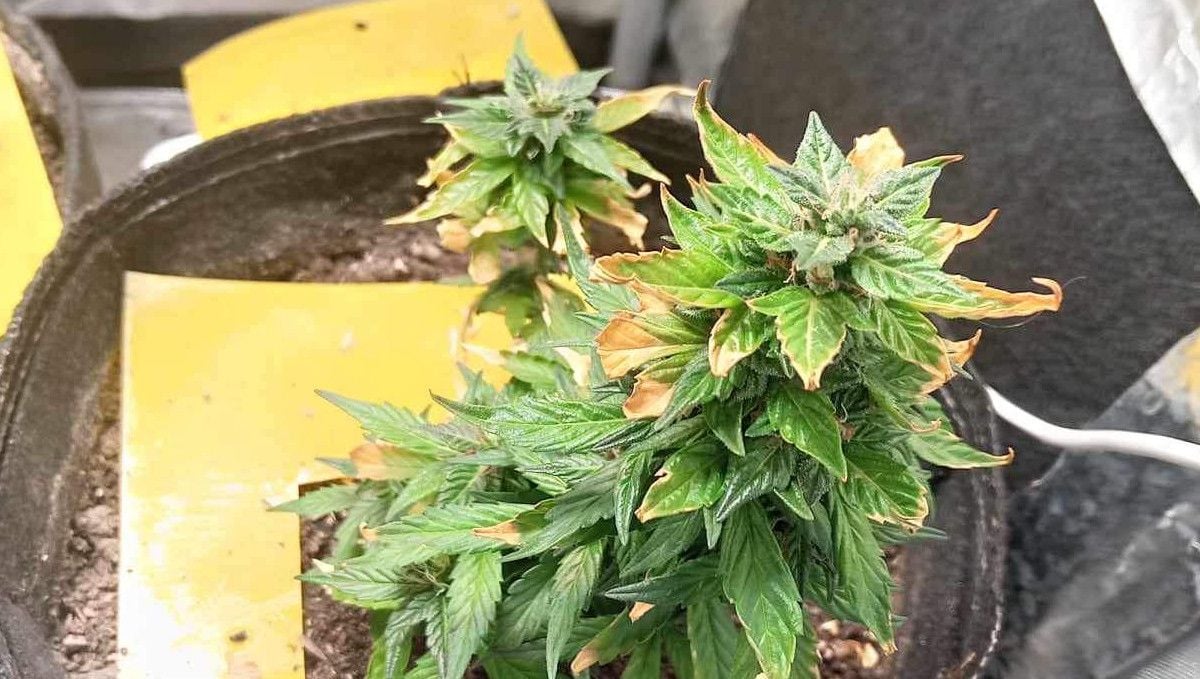
- Raised CO2 Levels. Ambient CO2 levels in a dwelling may be from 400 to 1000 ppm, and that’s enough for growing cannabis under normal temperature conditions. However, if the temps keep climbing – up to 30°C (86°F) and beyond – you may offset this by raising CO2 concentration to up to 1500 ppm. Some growers go even higher, but just keep in mind that working in a room full of CO2 may be bad for you or even dangerous.
- Light Schedule Adjustment. We’ve mentioned this before. If it’s too cold, add light hours, e.g. 20/4 instead of 18/6. If it’s too hot, make it 16/8. This is easy with vegging plants and autoflowers, but isn’t applicable to photoperiod plants during flowering – there, you can’t change the required schedule of 12/12 much (if at all). Some growers even experiment with such exotic light schedules as 6/2. Six hours of light and two hours of darkness repeated 3 times a day gives you exactly 18/6.
- Heating/Cooling the Medium. Since the temperature in the root zone is even more important than in the above-ground part, you can go a long way making sure the roots are neither cold nor hot. It means shadowing the containers from the sun and even grow lights, covering the ground with mulch outdoors, using heating mats or placing radiators at the container level, heating or cooling the water before watering. In hydroponics (DWC), the temperature of the nutrient solution should be around 18-20°C (65-68°F).
How Can You Control Temperature Outdoors?
When growing weed outdoors, you have much less control over the environment, but there are a few things you can do. If you’re worried about excessive heat, plant your cannabis in a spot that is in shadow during the hottest part of the day – in the early afternoon, and you can also use garden shade cloth. Cover the ground with a thick layer of mulch. When growing in pots, make sure their walls aren’t exposed to direct sun lest you want your roots to literally cook.

If it’s the cold you’re worried about, choose a strain that’s likely to finish before the cold weather begins in autumn. Sometimes, an autoflower planted for the warmest 2 months of summer is your only option. Choose a spot on a south-facing slope or against a wall that protects your garden from the north wind. Surround your weed patch on all sides by tall and thick shrubs but not too close lest they cast a shadow on your cannabis – it’s a good protection against cold winds. Grow your plants in pots rather than raised beds – this will allow you to move them inside for the night or during a spell of cold weather.
Final Thoughts
Temperature can be the single most important condition that makes or breaks your cannabis grow. Arguably, it’s even more important than the amount of light your weed receives. You need to pay attention to the temp levels in your garden at all times, and we hope our article has given you enough insight about how to achieve that. Happy growing!








